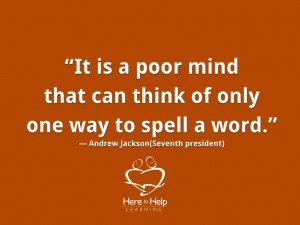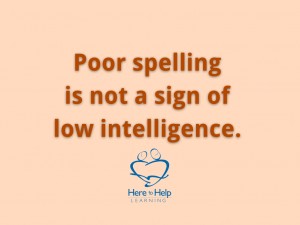
It is estimated that ten to fifteen percent of the population has dyslexia, a learning disability that is characterized by difficulties with reading and language processing. Many times, it is first discovered when a child has difficulty with spelling.
Growing up, I was one of those students who studied hard for my weekly spelling test only to eke out a “B.” And immediately after the test, all the words I learned seemed to vanish from my brain. Classroom spelling bees made my heart beat so rapidly; I thought I would explode. My sister’s elementary school writing is saved in a beautiful scrapbook. I am pretty sure mine is sitting in a landfill contributing to worldwide pollution. My papers were filled with spelling errors, and I think my mom wanted to save me the embarrassment by destroying the evidence. I still remember being laughed at in school because of spelling errors. I still remember the countless, “You just have to try harder” speeches I endured from teachers and my parents. I could not convince them of my efforts. I left high school keenly aware of my academic “limitations”.

By God’s grace, in my college years, I was asked by a Christian para-ministry to produce a monthly article for their newsletter. It was a good thing that no one knew my writing past. It was a turning point for me. I immersed myself in the writing process and loved it. During those years, my mentors, my editor, and my college professors helped me sharpen my writing skills. Writing became one of my favorite leisure activities that eventually led me to becoming a published author.
Looking back, I am positive I would have been diagnosed with dyslexia. I still transpose letters and numbers. I am still super self-conscious. I check and re-check my work many more times than the average writer. And I make sure that I take good care of the editors in my life.
However, I am grateful and thank God for my struggle with spelling. Over the years, I learned how to compensate for my spelling weakness. And in learning compensatory techniques, I am able to help students. Sometimes I laugh when I read the findings of some highly-funded report that claims a “newly discovered” strategy to help dyslexic students. It makes me sad to see parents spending hundreds of dollars on the latest cure. If you want to learn how to help dyslexic students, talk to a successful dyslexic adult. We learn effective strategies through sheer determination.

Full speed ahead into my our family’s homeschool years.
Unfortunately, dyslexics often beget dyslexics. And apparently, the dyslexic gene on the language arts DNA strand is pretty strong. So, some of my children have the same struggle. As a teacher, I refrain from the “just try harder” speech and deliver the “Can I show you strategies that might help?”. I instill in them and also shout from the front of my homeschool co-op classrooms with determined passion….
Don’t stop writing (Or anything else for that matter!)
because you struggle with spelling!

Poor spelling is not a sign of low intelligence.
Those who struggle with spelling are some of the most creative writers in history. Consider this list: Famous People with the Gift of Dyslexia.
One of my favorite HTHL writing students, a fourth-grade boy who struggles with spelling is one of the most creative young writers I have ever seen. I always smiled when I corrected his paper. In one instance, I was so impressed; he spelled the word “squirrel” five different ways….all incorrectly!

During my HTHL co-op teaching days, I was thanked by many moms because Here to Help Learning’s Writing Program emphasizes the Writing Process and does not shame the child for poor spelling. One of my students, a dyslexic fifth-grade girl told her mom after her first HTHL writing class, “I wish I knew before that writing could be so much fun.” Tears roll down my cheek when a mom tells me about their child, who feels safe enough to express thoughts on paper for the first time through HTHL’s writing approach.
How can you help a child who struggles with spelling?
1. Determine if Your Child has a Learning Disability: Before you give the “You Must Try Harder” speech, give your child the benefit of the doubt and learn The Signs of Dyslexia. Once I recognized it in myself and some of my children, it helped me as a homeschool mom on two levels. It yielded extra patience and bold determination. But labeling your child can be a scary thought, and I had to wrestle with my fears about the label of dyslexia. Will it hurt my child? Will the label prevent them from achieving their potential? Will it hinder them in any way?
2. Value the Importance of Learning to Spell: Sometimes I am tempted to minimize the importance of spelling. After all, we have spell check, right? See Part One of this blog for six reasons to value the ability to spell.
3. Provide a Solid Spelling Instruction Foundation: I cannot emphasize this enough. Provide your child with comprehensive spelling instruction including the 70 phonograms and spelling rules. It will require persistence and patience, but don’t skip it! ( See Part One of this blog) I found many high-expense dyslexic remedy programs that promise a “cure” and spend a vast amount of time providing (and charging you) for comprehensive spelling instruction, the same Orton Gillingham Approach used by All About Spelling.
4. Reroute Spelling Instruction: When we take a different turn in our car than what our GPS recommends, we hear the message, “rerouting”. “Rerouting” is what needs to happen in the brain of a struggling speller. They just need to utilize a different path to learning how to spell. Not every “rerouting” suggestion will work. So you will have to be a kind of rerouting sleuth. I encourage my child to be part of the process and pay attention to how his/her brain takes in information.
So here are some alternate routes to the end goal of learning to spell.
Rerouting The Spelling List
Alternate Route One: Ditch the preprinted spelling book and create a personal spelling notebook. Using a preprinted spelling book was very discouraging for my struggling spellers. Who wants to “fail” their spelling test week after week? So every year, my student created his/her own spelling workbook. I use a sewn composition book which prevents lost pages. It becomes a personal year-long spelling reference book.

Alternate Route Two: Write and review the spelling rules on the first seven pages every year.
Use the All About Spelling spelling rules.

Alternate Route Three: Learn and review the 70 phonograms. Again, use All About Spelling test and retest using flashcards every day. The most troubling phonograms are placed on the student’s personal phonogram list of 5-10 phonograms with a corresponding word example. These are practiced daily by saying and writing the sound. My student also listens to me say the sound and writes it. It takes about ten minutes. I change this list weekly.

Alternate Route Four: The Student’s Personal Spelling List
1. I use words from the “Frequently Used Word” list.
2. I initially limit the spelling list to 5-15 words.
3. I also find it helpful to group similar words together.
Word families and rhyming words
Example: make, take, rake, snake
Homophones: Words that sound the same but are spelled differently
Example-Brake and break
Base words with different endings
Example: music/musical/musician are assigned together.
Root words with prefixes or suffixes
Example: prehistoric (“pre-” means before)
Example: experiment (“-ment” means state or condition)
Rerouting: Introducing New Spelling Words
I use a combination of eight different paths to introduce spelling words. I find the more paths I offer my student, the better the outcome.

1. Write the word as you say or sing the sound of the letter and not the name of the letter.
2. Break the word up into syllables.
3. Learn and add phonogram “markings”. (Example: a long line over an a symbolizes the long “a” sound)
4. Site the Spelling Rules for the word. My younger student dictates the rule to me.
5. Block or outline the word-Take a different color and outline the word shape.
6. Color code the phonograms with two or more letters. (Example: ie, igh or ough). I mark all silent “e”s in red.
7. List the word family- Use Rhyme Zone to find word families.
8. Create a way to remember the word.
- Look for small words in the word and make a sentence with the smaller word. Example: Journal- I love OUR journal!
- Look for letters that can make words in a sentence.
- Example: Saturday- Saturday, YOU(u) ARE(r) my day!
- Exaggerate the sound and write the word to emphasize the softer sounds in the word. Example: Diamond…..say “Di-….A...mond”
- Draw pictures to remember the word.
- Example: The word “lose” versus the word “loose”. Draw an epic battle between the words. Of course, at some point in the battle the “o” is tragically lost and becomes the word “lose”. The more dramatic and emotional the pictures are the better it will be remembered!
Rerouting Retention
Spelling Games: Introducing spelling games can be tricky. I HATE word games. Growing up as a poor speller, I came in last in every word game I’ve ever played. Always. Who enjoys coming in last? However, playing with Scrabble tiles or Boggle did help me to retain the words I was learning. I found homeschool success by allowing my child to play alone or just with me without the competition.
Check out HTHL’s Pinterest board on Word Games.
Hands-On Stuff: Hands-on activities are where my A.D.D. kicks in (Coffee actually relaxes me. I can sleep 20 minutes after a strong cup of java.) Ready? Why write the words just with paper and a pencil when there are so many other ways to practice spelling words? I often use hands-on techniques to help a student who is stuck on a spelling word.
- Sandpaper: Write the word on the sandpaper and trace the letters with a finger.
- Chalk: Write spelling words on your driveway using large letters.
- Squirt gun: Write words on a driveway with water.
- Cold windows: Write spelling words on frosted windows.
- Play dough: Make 3-D spelling words that stand up.
- Glue and glitter: Write the word in glue and sprinkle with glitter.
- Cake: Spell words on cake or cupcakes.
- Popsicle Sticks: Write letters on each stick and create words.
- Finger paints: Write spelling words with finger paints.
- Air Spell: Spell words in the air with eyes open, eyes closed, and with both hands.
- Feather pen: Write spelling words with a feather chiseled to a point dipped in black paint.
- Magnet Letters: Arrange into spelling words
- Block Letters: Arrange into spelling words
- Tile Letters: Arrange into spelling words
- Paint spelling words
- Letter Ink Stamps
- Lego Blocks: Write phonograms and letters on blocks with a permanent marker and click the blocks together.
- Chocolate syrup in the shape of letters on graham crackers and lick it off. (Always a favorite!)
- Beach Spelling: Write words in a tray of sand.
- Cursive Writing: Cursive writing has helped many dyslexic students. (Note: “b” and “d”s are not reversed in cursive writing.)
- Write On Boards with varied color markers
- Black Chalkboards with varied colored chalk
- Learn American Sign Language Fingerspelling- I took three years of fingerspelling in college, and it helped me.
- Morse Code or Braille Dots
- Computer Drawing Pads
- Large Poster Board or Butcher Paper: Roll out paper onto the table. Allow your student to write spelling words throughout the day.
But wait, there’s more! Check out HTHL’s Pinterest board for more hands-on spelling ideas!
Rerouting Spelling Review
There is only one computer spelling game that I love- Spelling City.com. Here is why I am sold on this product.
- I can customize a spelling list for my child.
- I can track my child’s progress.
- It has audio.
- It has a lot of games and practice spelling tests.
- It can generate penmanship worksheets (Print and Cursive).
- It can generate fingerspelling worksheets.
- It offers featured spelling lists.
- It has an app.
- It is inexpensive.
- My whole family can use it.
Rerouting Research Habits
When I was growing up, “Look it up” was the phrase I heard over and over when I couldn’t spell a word. I don’t think my parents understood the jumbled letters in my mind. Opening a dictionary was equal to jumping off a cliff into a chasm of thousands upon millions of horrifying letters, wrapping their protruding appendages around my throat. (I told you, we dyslexics are creative.)
So here is how I help. If my struggling speller asks me for a word…..wait for it…… I give it to them.
To send them into a dictionary chasm just seems cruel. I use the request to teach them how to spell the word, using all of the above techniques. But wait, Beth, no dictionary? Have no fear, we spent a lot of time looking up actual vocabulary words, but not spelling words. Also, I did not allow computer spell check until I was confident my student had a command of spelling rules and a grasp of how to spell most of the words on the Frequently Used Word List. For my dyslexic students, it usually occurs when they learn how to type, which is about seventh grade. Be aware that spell check can make lazy spellers, and nowadays, some computers have “predictive spelling” which reinforces poor spelling. The predictive spelling program records how the user incorrectly spells a word and delivers the correct word before the user has the time to think it through. We have to evaluate computer “help”. Does it really help or hinder?
Rerouting Spelling Success
Many times in formal education, the guiding principle is “Teacher Knows Best”. However, in the jungles of dyslexia, the student often unlocks the secrets to success. I frequently ask my struggling speller,” Where are you finding success?” Invite your child to discover the pathways to spelling correctly. If they locate a path that leads to the goal, use it, but be willing to change it when the road is again filled with hanging branches and debris.
Rerouting the Myth of Poor Spellers Equals Low Intelligence
Being a poor speller does not mean low intelligence. And you as the parent and teacher have the upward fight to dispel this myth in your student despite societal judgments. Reassure your child that his/her brain is just wired differently. And most importantly, it’s okay. Just because a school system or curriculum is bent on teaching spelling a certain way does not mean it’s the only way. It is not a reflection of intelligence, and it is certainly not a reflection of creativity and other untestable qualities or character.
A story for you….
For my daughter’s birthday party, we stretched a long piece of butcher paper over the table so her friends could doodle Happy Birthday wishes. One doodle caught my eye. It was written in Japanese. I found the friend who wrote it and asked her what it meant. She said it was a Japanese proverb. I was impressed with this young high schooler. I asked her why she chose to learn Japanese. She told me, “I have dyslexia. And although I have had a learning disability plan in place since elementary school, (she attends public school) my parents told me never to let it limit what I wanted to do. In my sophomore year in high school, I asked my counselor to sign me up for a foreign language class. She told me it was out of the question, because of my dyslexia diagnosis. She refused to sign me up for the class despite my desire. So, I left the office and searched on the internet for the hardest language to learn. I discovered the most difficult language for an American to learn was Japanese, and I began to teach myself.”
Impressive.

Parents and teachers, we CAN lift up a struggling speller out of the labyrinth of dyslexia. We can inspire thoughtful expression and creativity in writing.
People with dyslexia are often the most creative and resilient people I know.
From Our Home to Yours,
First published: November 25, 2014
Updated: August 19, 2023









